Numerical and Experimental Spray Analysis of Castor and Jatropha Biodiesel under Non-Evaporating Conditions
Abstract
1. Introduction
2. Numerical Methodology
2.1. Injection Model
2.2. Primary Atomization Model (Wave Model)
2.3. Secondary Breakup Model (KH–RT)
2.4. TAB Breakup Model
2.5. O’Rourke Collision Model
2.6. Drag Model
2.7. Governing Equations
3. Simulation Setup
Mesh Study
4. Experimental Setup
Image Processing
5. Results
5.1. Comparison of Breakup Models
5.2. Penetration Length
5.3. Drop Diameter
5.4. Spray Cone Angle
5.5. Spray Area
6. Conclusions
Author Contributions
Funding
Data Availability Statement
Conflicts of Interest
Nomenclature
| IP | Injection pressure |
| TAB | Taylor Analogy Breakup |
| KHRT | Kelvin–Helmholtz and Rayleigh–Taylor |
| AMD | Average mean diameter |
| SMD | Sauter mean diameter |
| PM | Particulate matter |
| UHC | Unburned hydrocarbons |
| CO | Carbon monoxide |
| NOx | Nitrogen oxides |
| PL | Penetration length |
| SCA | Spray cone angle |
| CVV | Control volume vessel |
| JB-100 | 100% Jatropha biodiesel |
| CB-100 | 100% Castor biodiesel |
| JB-20 | 20% Jatropha biodiesel and 80% diesel |
| CB-20 | 20% Castor biodiesel & 80% diesel |
| CaME | Castor methyl esters |
| KHACT | Kelvin–Helmholtz aerodynamic cavitation turbulence |
| EACT | Enhanced aerodynamic cavitation turbulence |
| LISA | Linearized instability sheet atomization |
| ΛKH | Maximum wavelength |
| ΩKH | Growth rate |
| ΩRT | Frequency of the fastest growing wave |
| Density | |
| Velocity in i direction | |
| Shear Stresses | |
| Body Force | |
| Total energy | |
| Rate of production of kinetic energy | |
| Kinetic energy production rate due to turbulence | |
| Enthalpy | |
| Diffusion Flux | |
| Viscosity | |
| Turbulent Viscosity | |
| Prandtl numbers for k and | |
| Production of because of mean velocity gradients | |
| User-defined source terms | |
| YM | Fluctuating dilation factor |
References
- Gao, Y.; Deng, J.; Li, C.; Dang, F.; Liao, Z.; Wu, Z.; Li, L. Experimental study of the spray characteristics of biodiesel based on inedible oil. Biotechnol. Adv. 2009, 27, 616–624. [Google Scholar] [CrossRef] [PubMed]
- Fu, W.; Song, L.; Yi, B.; Liu, T.; Li, F.; Lin, Q. Experimental and theoretical analysis of the spray characteristics of a high-pressure common-rail injection system fueled with neat biodiesel, ethanol-biodiesel blends, and neat diesel fuel. J. Energy Eng. 2017, 143, 04017060. [Google Scholar] [CrossRef]
- Nirmala, N.; Dawn, S.S.; Harindra, C. Analysis of performance and emission characteristics of Waste cooking oil and Chlorella variabilis MK039712.1 biodiesel blends in a single cylinder, four strokes diesel engine. Renew. Energ. 2020, 147, 284–292. [Google Scholar] [CrossRef]
- Nabi, M.N.; Rasul, M.G. Influence of second generation biodiesel on engine performance, emissions, energy and exergy parameters. Energy Convers. Manag. 2018, 169, 326–333. [Google Scholar] [CrossRef]
- Asokan, M.A.; Senthur Prabu, S.; Bade, P.K.K.; Nekkanti, V.M.; Gutta, S.S.G. Performance, combustion and emission characteristics of juliflora biodiesel fuelled DI diesel engine. Energy 2019, 173, 883–892. [Google Scholar] [CrossRef]
- Zhong, W.; Tamilselvan, P.; Wang, Q.; He, Z.; Feng, H.; Yu, X. Experimental study of spray characteristics of diesel/hydrogenated catalytic biodiesel blended fuels under inert and reacting conditions. Energy 2018, 153, 349–358. [Google Scholar] [CrossRef]
- Yu, S.; Yin, B.; Deng, W.; Jia, H.; Ye, Z.; Xu, B.; Xu, H. Experimental study on the diesel and biodiesel spray characteristics emerging from equilateral triangular orifice under real diesel engine operation conditions. Fuel 2018, 224, 357–365. [Google Scholar] [CrossRef]
- Yu, S.; Yin, B.; Jia, H.; Wen, S.; Li, X.; Yu, J. Theoretical and experimental comparison of internal flow and spray characteristics between diesel and biodiesel. Fuel 2017, 208, 20–29. [Google Scholar] [CrossRef]
- Das, M.; Sarkar, M.; Datta, A.; Santra, A.K. Study on viscosity and surface tension properties of biodiesel-diesel blends and their effects on spray parameters for CI engines. Fuel 2018, 220, 769–779. [Google Scholar] [CrossRef]
- Xie, H.; Song, L.; Xie, Y.; Pi, D.; Shao, C.; Lin, Q. An experimental study on the macroscopic spray characteristics of biodiesel and diesel in a constant volume chamber. Energies 2015, 8, 5952–5972. [Google Scholar] [CrossRef]
- Ulu, A.; Yildiz, G.R.; Rodriguez, A.D.; Özkol, U. Spray Analysis of Biodiesels Derived from Various Biomass Resources in a Constant Volume Spray Chamber. ACS Omega 2022, 7, 19365–19379. [Google Scholar] [CrossRef]
- Mohan, B.; Yang, W.; Tay, K.L.; Yu, W. Experimental study of spray characteristics of biodiesel derived from waste cooking oil. Energy Convers. Manag. 2014, 88, 622–632. [Google Scholar] [CrossRef]
- Patel, C.; Lee, S.; Tiwari, N.; Agarwal, A.K.; Lee, C.S.; Park, S. Spray characterization, combustion, noise and vibrations investigations of Jatropha biodiesel fuelled genset engine. Fuel 2016, 185, 410–420. [Google Scholar] [CrossRef]
- Lee, S.; Lee, C.S.; Park, S.; Gupta, J.G.; Maurya, R.K.; Agarwal, A.K. Spray characteristics, engine performance and emissions analysis for Karanja biodiesel and its blends. Energy 2017, 119, 138–151. [Google Scholar] [CrossRef]
- Agarwal, A.K.; Som, S.; Shukla, P.C.; Goyal, H.; Longman, D. In-nozzle flow and spray characteristics for mineral diesel, Karanja, and Jatropha biodiesels. Appl. Energy 2015, 156, 138–148. [Google Scholar] [CrossRef]
- Sathiyamoorthi, R.; Sankaranarayanan, G.; Munuswamy, D.B.; Devarajan, Y. Experimental study of spray analysis for Palmarosa biodiesel-diesel blends in a constant volume chamber. Environ. Prog. Sustain. Energy 2021, 40, e13696. [Google Scholar] [CrossRef]
- Bohl, T.; Tian, G.; Smallbone, A.; Roskilly, A.P. Macroscopic spray characteristics of next-generation bio-derived diesel fuels in comparison to mineral diesel. Appl. Energy 2017, 186, 562–573. [Google Scholar] [CrossRef]
- Cai, G.; Abraham, J. Multidimensional simulations of non-reacting and reacting diesel and biodiesel sprays. Energy 2017, 119, 1221–1229. [Google Scholar] [CrossRef]
- Battistoni, M.; Grimaldi, C.N. Numerical analysis of injector flow and spray characteristics from diesel injectors using fossil and biodiesel fuels. Appl. Energy 2012, 97, 656–666. [Google Scholar] [CrossRef]
- Som, S.; Longman, D.E.; Ramírez, A.I.; Aggarwal, S.K. A comparison of injector flow and spray characteristics of biodiesel with petrodiesel. Fuel 2010, 89, 4014–4024. [Google Scholar] [CrossRef]
- Moon, S. Novel insights into the dynamic structure of biodiesel and conventional fuel sprays from high-pressure diesel injectors. Energy 2016, 115, 615–625. [Google Scholar] [CrossRef]
- Ogunniyi, D.S. Castor oil: A vital industrial raw material. Bioresour. Technol. 2006, 97, 1086–1091. [Google Scholar] [CrossRef] [PubMed]
- Keera, S.T.; El Sabagh, S.M.; Taman, A.R. Castor oil biodiesel production and optimization. Egypt. J. Pet. 2018, 27, 979–984. [Google Scholar] [CrossRef]
- Azad, A.K.; Rasul, M.G.; Khan, M.M.K.; Sharma, S.C.; Mofijur, M.; Bhuiya, M.M.K. Prospects, feedstocks and challenges of biodiesel production from beauty leaf oil and castor oil: A nonedible oil sources in Australia. Renew. Sustain. Energy Rev. J. 2016, 61, 302–318. [Google Scholar] [CrossRef]
- Som, S.; Aggarwal, S.K. Effects of primary breakup modeling on spray and combustion characteristics of compression ignition engines. Combust. Flame 2010, 157, 1179–1193. [Google Scholar] [CrossRef]
- Fu, W.; Li, F.; Meng, K.; Liu, Y.; Shi, W.; Lin, Q. Experiment and analysis of spray characteristics of biodiesel blending with di-n-butyl ether in a direct injection combustion chamber. Energy 2019, 185, 77–89. [Google Scholar] [CrossRef]
- Zhang, J.; Fang, T. Spray Combustion of Biodiesel and Diesel in a Constant Volume Combustion Chamber. SAE Tech. Pap. 2011, 2011-011380. [Google Scholar] [CrossRef]
- Baumgarten, C. Mixture Formation in Internal Combustion Engines; Springer Science & Business Media: Berlin/Heidelberg, Germany, 2006. [Google Scholar]
- Som, S.; Aggarwal, S.K.; El-Hannouny, E.; Longman, D. Investigation of nozzle flow and cavitation characteristics in a diesel injector. J. Eng. Gas Turbines Power 2010, 132, 042802. [Google Scholar] [CrossRef]
- Zeidi, S.J.; Dulikravich, G.S.; Reddy, S.R.; Darvish, S. Effects of needle lift and fuel type on cavitation formation and heat transfer inside diesel fuel injector nozzle. In Proceedings of the CHT-17 ICHMT International Symposium on Advances in Computational Heat Transfer, Napoli, Italy, 28 May–1 June 2017. [Google Scholar]
- Chaudhari, V.; Kulkarni, A.; Deshmukh, D. Spray characteristics of biofuels for advance combustion engines. Cleaner Eng. Technol. 2021, 5, 100265. [Google Scholar] [CrossRef]
- Park, S.H.; Kim, H.J.; Lee, C.S. Comparison of experimental and predicted atomization characteristics of high-pressure diesel spray under various fuel and ambient temperature. J. Mech. Sci. Technol. 2010, 24, 1491–1499. [Google Scholar] [CrossRef]
- Ghasemi, A.; Djavareshk, M. Investigation of the effects of natural gas equivalence ratio and piston bowl flow field on combustion and pollutant formation of a DI dual fuel engine. J. Appl. Sci. 2010, 10, 1369–1379. [Google Scholar] [CrossRef]
- Diviš, M.; Macek, J. Fuel injection process computations using the eulerian multidimensional model. SAE Tech. Pap. 2005, 01-1243. [Google Scholar] [CrossRef]
- Wang, Y.; Lee, W.G.; Reitz, R.D.; Diwakar, R. Numerical Simulation of Diesel Sprays Using an Eulerian-Lagrangian Spray and atomization (ELSA) model coupled with nozzle flow. SAE Tech. Pap. 2011, 2011-01-0386. [Google Scholar] [CrossRef]
- Lin, S.; Ding, L.; Zhou, Z.; Yu, G. Discrete model for simulation of char particle gasification with structure evolution. Fuel 2016, 186, 656–664. [Google Scholar] [CrossRef]
- Thiruvengadam, M.; Zheng, Y.; Tien, J.C. DPM simulation in an underground entry: Comparison between particle and species models. Int. J. Min. Sci. Technol. 2016, 26, 487–494. [Google Scholar] [CrossRef]
- Djavareshkian, M.H.; Ghasemi, A. Investigation of jet break-up process in diesel engine spray modelling. J. Appl. Sci. 2009, 9, 2078–2087. [Google Scholar] [CrossRef][Green Version]
- Fu-shui, L.; Lei, Z.; Bai-gang, S.; Zhi-jie, L.; Schock, H.J. Validation and modification of WAVE spray model for diesel combustion simulation. Fuel 2008, 87, 3420–3427. [Google Scholar] [CrossRef]
- Jing, D.; Zhang, F.; Li, Y.; Xu, H.; Shuai, S. Experimental investigation on the macroscopic and microscopic spray characteristics of dieseline fuel. Fuel 2017, 199, 478–487. [Google Scholar] [CrossRef]
- Pees, S.; Hoffmann, A.; Zivojnovic, V.; Meyr, H. LISA—Machine description language for cycle-accurate models of programmable DSP architectures. In Proceedings of the 36th Annual ACM/IEEE Design Automation Conference, New Orleans, LA, USA, 21–25 June 1999; pp. 933–938. [Google Scholar]
- Ghasemi, A.; Fukuda, K.; Balachandar, R.; Barron, R. Numerical Investigation of Spray Characteristics of Diesel Alternative Fuels. SAE Tech. Pap. 2012, 2012-01-1265. [Google Scholar] [CrossRef]
- Beck, J.; Watkins, A. The droplet number moments approach to spray modelling: The development of heat and mass transfer sub-models. Int. J. Heat Fluid Flow 2003, 24, 242–259. [Google Scholar] [CrossRef]
- Reitz, R.D. Modeling atomization processes in high-pressure vaporizing sprays. At. Sprays Technol. 1987, 3, 309–337. [Google Scholar]
- Beale, J.C.; Reitz, R.D. Modeling spray atomization with the Kelvin-Helmholtz/Rayleigh-Taylor hybrid model. At. Sprays 1999, 9, 623–650. [Google Scholar]
- Lee, C.S.; Park, S.W. An experimental and numerical study on fuel atomization characteristics of high-pressure diesel injection sprays. Fuel 2002, 81, 2417–2423. [Google Scholar] [CrossRef]
- Su, T.; Patterson, M.; Reitz, R.D.; Farrell, P. Experimental and numerical studies of high pressure multiple injection sprays. SAE Trans. 1996, 105, 1281–1292. [Google Scholar]
- Ashgriz, N.; Poo, J. Coalescence and separation in binary collisions of liquid drops. J. Fluid Mech. 1990, 221, 183–204. [Google Scholar] [CrossRef]
- Liu, A.B.; Mather, D.; Reitz, R.D. Modeling the effects of drop drag and breakup on fuel sprays. SAE Trans. 1993, 102, 83–95. [Google Scholar]
- Shih, T.-H.; Liou, W.W.; Shabbir, A.; Yang, Z.; Zhu, J. A new k-ϵ eddy viscosity model for high reynolds number turbulent flows. Comput. Fluids 1995, 24, 227–238. [Google Scholar] [CrossRef]
- Passaras, D.; Amanatides, E.; Kokkoris, G. Predicting the flow of cold plasma jets in kINPen: A critical evaluation of turbulent models. J. Phys. D Appl. Phys. 2020, 53, 265202. [Google Scholar] [CrossRef]
- Kumar, A.; Ghobadian, A.; Nouri, J. Numerical simulation and experimental validation of cavitating flow in a multi-hole diesel fuel injector. Int. J. Engine Res. 2021, 23, 958–973. [Google Scholar] [CrossRef]
- Pattamatta, A.; Singh, G. Assessment of turbulence models in the prediction of flow field and thermal characteristics of wall jet. Front. Heat Mass Transf. 2012, 3, 023005. [Google Scholar] [CrossRef]
- Hiroyasu, H.; Arai, M.; Tabata, M. Empirical equations for the sauter mean diameter of a diesel spray. SAE Trans. 1989, 98, 868–877. [Google Scholar]
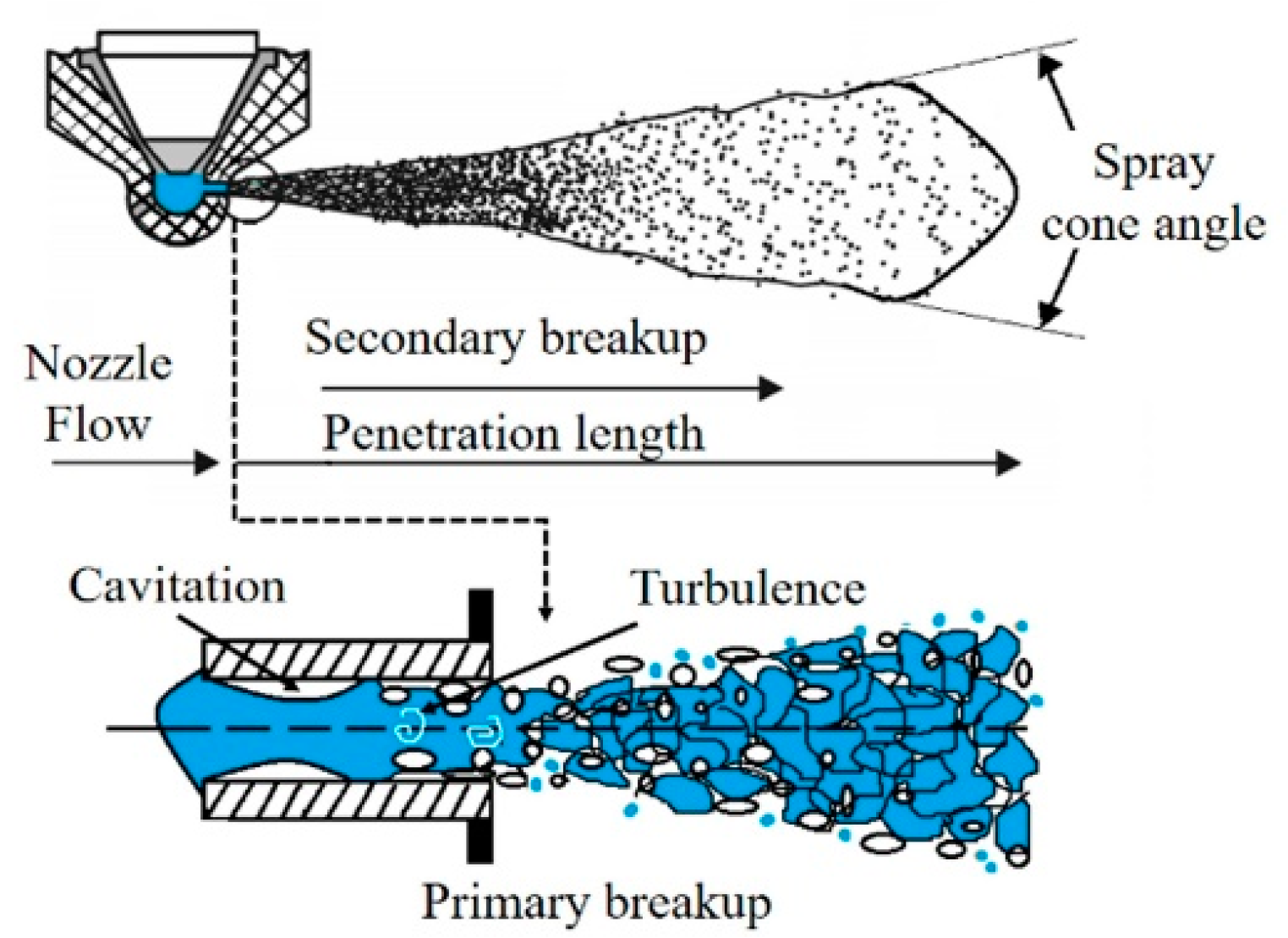
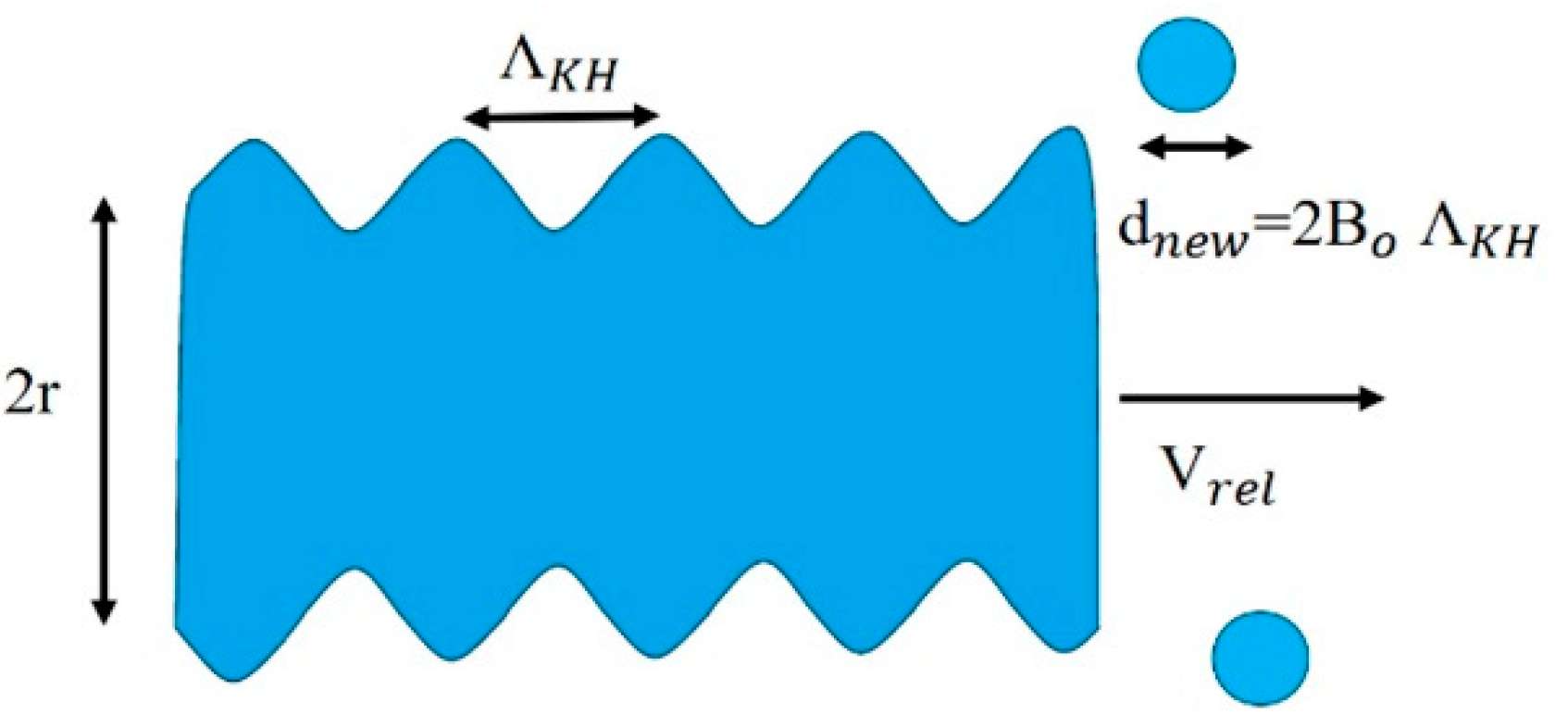
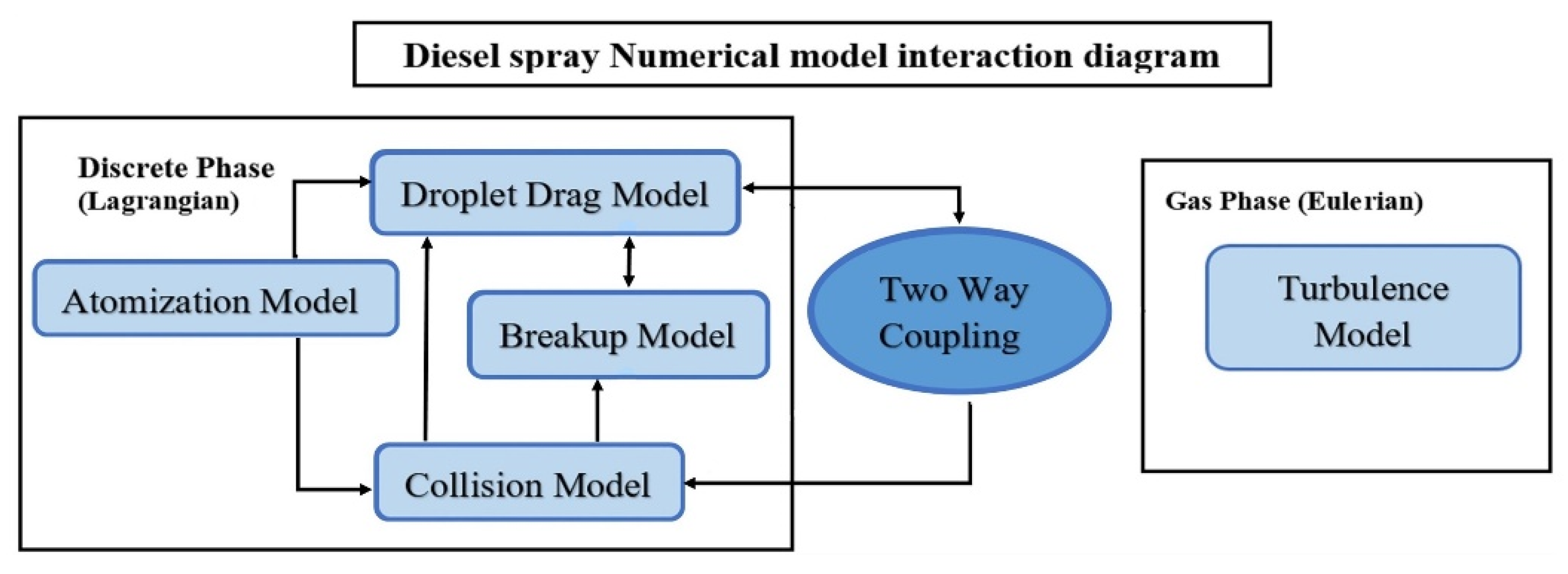
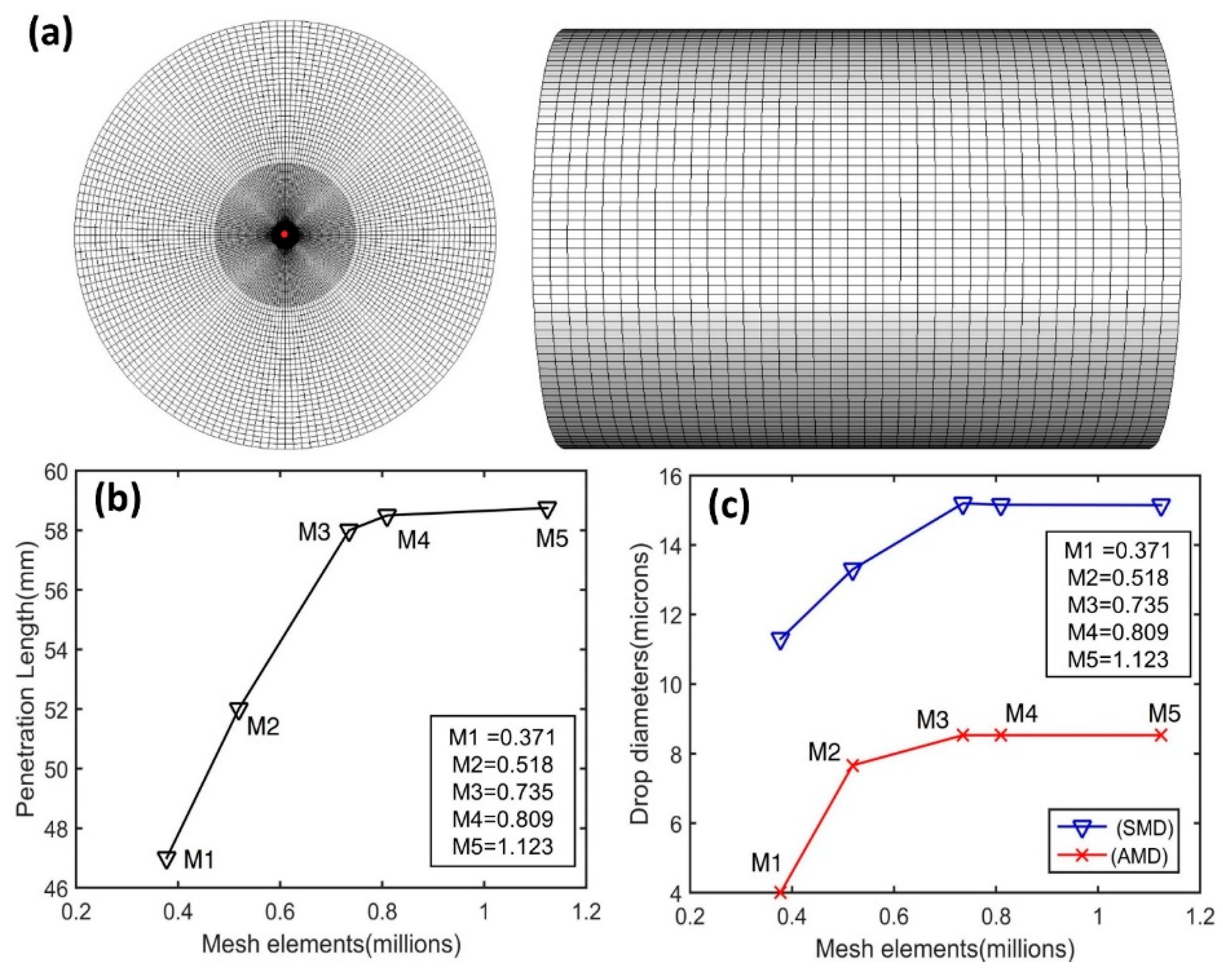

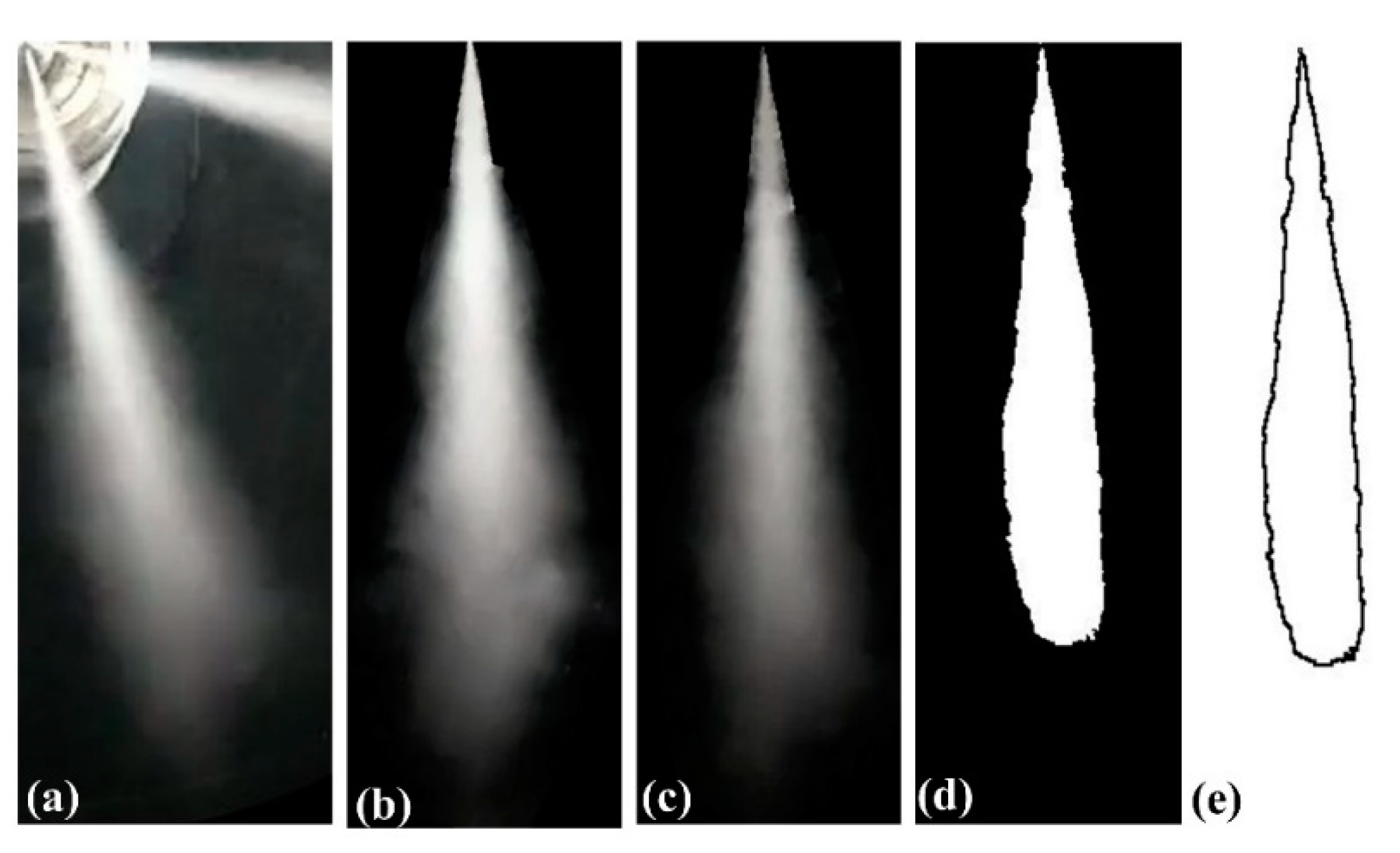
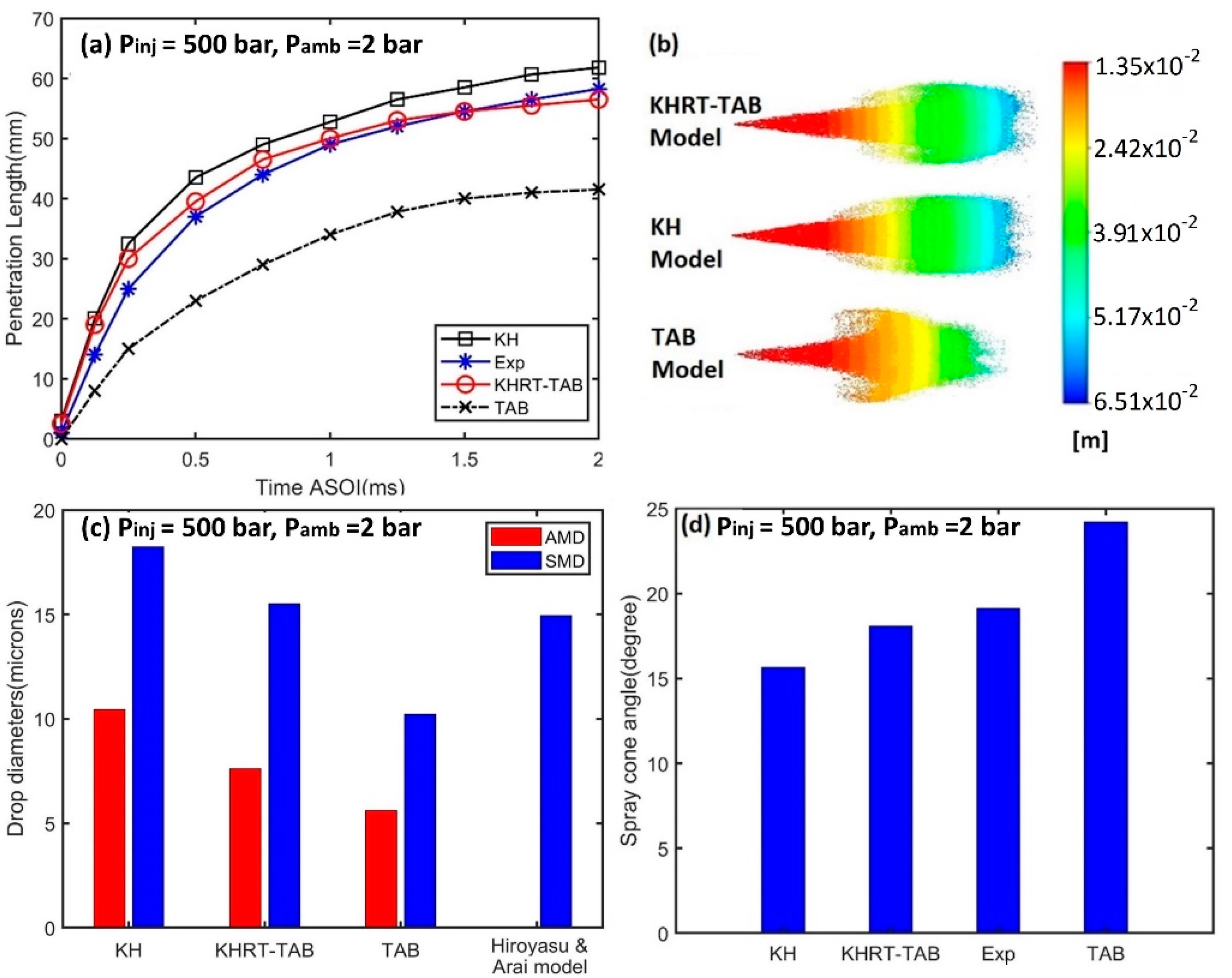
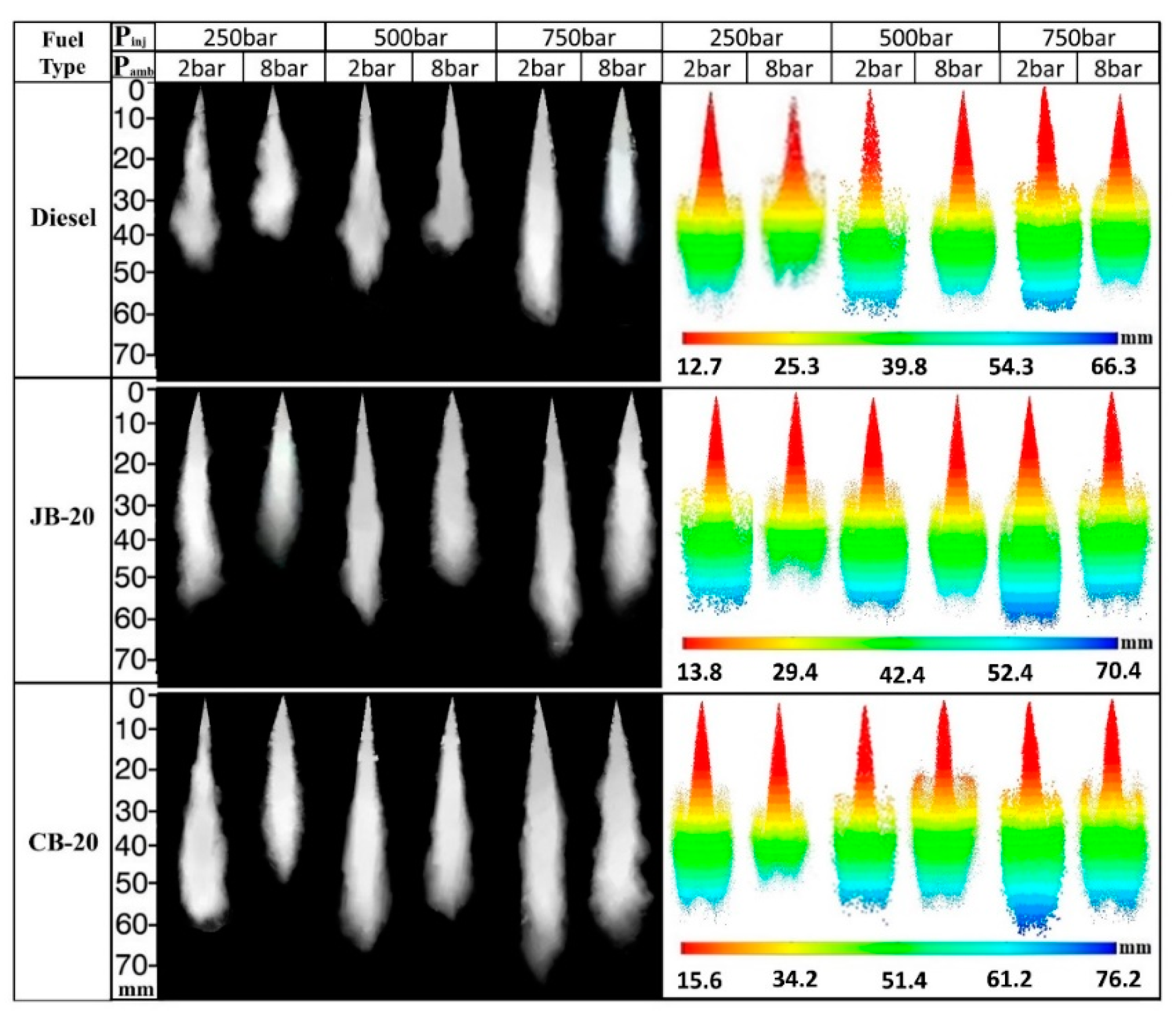




| Parameter | Quantity |
|---|---|
| Injection pressure (bar) | 250, 500, 750 |
| Injection temperature (K) | 300 |
| Back pressure (bar) | 2, 5, 8 |
| Nozzle diameter (mm) | 0.290 |
| Nozzle length (mm) | 1.8 |
| Mass flow rate (g/s) | 4, 5, 6 |
| Injection duration (ms) | 1.5, 2, 2.5 |
| Chamber length (mm) | 180 |
| Chamber diameter (mm) | 150 |
| Chamber temperature (K) | 300 |
| Property | Castor Biodiesel (CB-100) | Jatropha Biodiesel (JB-100) | Diesel D100 | 20% Jatropha Biodiesel & 80% Diesel (JB-20) | 20% Castor Biodiesel & 80% Diesel (CB-20) |
|---|---|---|---|---|---|
| Density (kg/m3) | 915.7 | 881 | 828 | 841.6 | 858.2 |
| Viscosity (mPa.s) | 14.72 | 6.89 | 2.60 | 3.47 | 3.86 |
| Surface tension (mN/m) | 34.10 | 31.2 | 27.80 | 28.7 | 29.11 |
| Calorific value (MJ/kg) | 38.262 | 40.07 [13] | 45.796 | 42.47 [13] | 43.89 |
Publisher’s Note: MDPI stays neutral with regard to jurisdictional claims in published maps and institutional affiliations. |
© 2022 by the authors. Licensee MDPI, Basel, Switzerland. This article is an open access article distributed under the terms and conditions of the Creative Commons Attribution (CC BY) license (https://creativecommons.org/licenses/by/4.0/).
Share and Cite
Haq, M.u.; Jafry, A.T.; Abbasi, M.S.; Jawad, M.; Ahmad, S.; Cheema, T.A.; Abbas, N. Numerical and Experimental Spray Analysis of Castor and Jatropha Biodiesel under Non-Evaporating Conditions. Energies 2022, 15, 7808. https://doi.org/10.3390/en15207808
Haq Mu, Jafry AT, Abbasi MS, Jawad M, Ahmad S, Cheema TA, Abbas N. Numerical and Experimental Spray Analysis of Castor and Jatropha Biodiesel under Non-Evaporating Conditions. Energies. 2022; 15(20):7808. https://doi.org/10.3390/en15207808
Chicago/Turabian StyleHaq, Muteeb ul, Ali Turab Jafry, Muhammad Salman Abbasi, Muhammad Jawad, Saad Ahmad, Taqi Ahmad Cheema, and Naseem Abbas. 2022. "Numerical and Experimental Spray Analysis of Castor and Jatropha Biodiesel under Non-Evaporating Conditions" Energies 15, no. 20: 7808. https://doi.org/10.3390/en15207808
APA StyleHaq, M. u., Jafry, A. T., Abbasi, M. S., Jawad, M., Ahmad, S., Cheema, T. A., & Abbas, N. (2022). Numerical and Experimental Spray Analysis of Castor and Jatropha Biodiesel under Non-Evaporating Conditions. Energies, 15(20), 7808. https://doi.org/10.3390/en15207808









